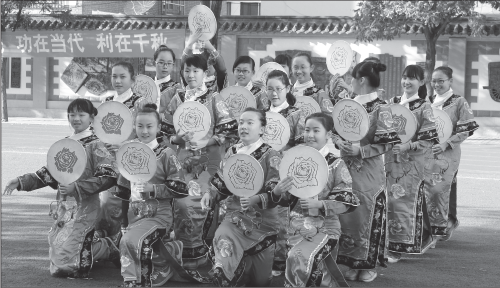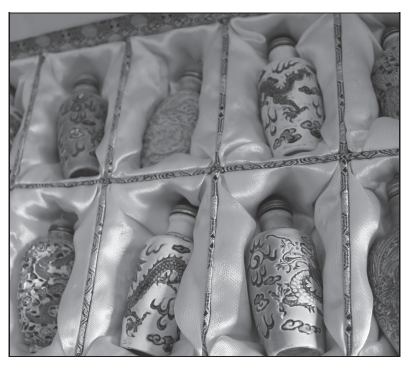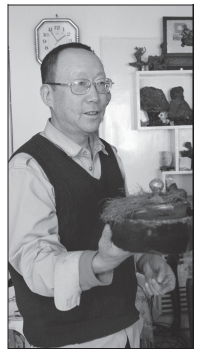
WANG KAIHAO/CHINA DAILY
Students at the Manchu Elementary School in Hohhot wear traditional Manchu attire and perform taipinggu, a dance with hand-held drums.

WANG KAIHAO/CHINA DAILY
Snuff bottles, collected by Xu Xianjun, were once used by Manchu nobles.

WANG KAIHAO/CHINA DAILY
Song Aihe, a descendant of a Manchu general of the late Qing Dynasty, shows off his personal collection of antique artifacts from Manchus' daily lives.
Since recently retiring from a construction company in Hohhot, capital of the Inner Mongolia autonomous region, Song Aihe finally has some free time to care for the flowers and vegetables in his modest yard.
When he trims the withering vines this winter, a pole that resembles a streetlamp, gradually becomes apparent in one corner.
"That is our sacred pole," says the 60-year-old, who is from the Manchu ethnic group. "You will probably not find another in Hohhot now, though it was essential for every Manchu family in the past."
The pole represents respect for crows. According to legend, Nurhaci, the 17th century's Manchu leader and the predecessor of emperors in the Qing Dynasty (1644-1911), was once saved by crows as he escaped from advancing enemies.
Song's home is in Xincheng (literally meaning "new town") district, located in the northern part of the city's downtown area.
The "new town" was formed in 1739, when more than 3,000 Manchu soldiers were ordered by the emperor to build a military base. It was commonly called "new town", distinguishing it from the older part of Hohhot in the south, where Mongolians were the majority.
Their descendants, comprising one of the largest Manchu communities in Inner Mongolia, have been exploring various ways to honor the history.
About 10,000 Manchu people live in Xincheng district, one-third of the ethnic group's population in Hohhot. In Inner Mongolia, the Manchu are the second most populous non-Han ethnic group, after Mongolians.
Song rummages through boxes and proudly shows his personal collection of artifacts, which covers almost every aspect of Manchus' daily lives. He is a descendant of a general of the late Qing Dynasty, and he has a great interest in Manchu culture.
"Before, it was easy to collect these items," he recalls. "I used to exchange a kilogram of snacks for a large bag of old everyday stuff. I never took it seriously until 1997 when the collection industry boomed, and I dedicated all my free time to it.
"I only buy them and never sell any," he smiles. "I feel kind of like a collectomaniac, but it's worthwhile. These are visible history."
His daughter's wedding is scheduled for December, and he is busily preparing a Manchu-style ritual, which is known for its complicated process and fine costumes. He says some old items can also be used then.
Wealthier collectors have taken their hobby to the next level. Xu Xianjun, 46, has an antique collection he claims is worth an estimated 300 million yuan ($49.3 million), of which 70 percent of the items are related to his ethnic group. The Manchu from Hohhot made his wealth through his logistics conglomerate and is, perhaps, the biggest private collector of Manchu items in Inner Mongolia.
"I like to divide these items into categories, like costumes and musical instruments," he says.
Among Xu's favorite collections are 800 luxurious snuff bottles, which he says reflect the lives of Manchu nobles and merchants as well as the old trade route in Inner Mongolia.
"Some snuff bottles are much bigger than the regular size, because the merchants traveling northwards to Russia or even further places would not return home for a number of years. They had to bring enough tobacco," he says.
"I've known from the very beginning that I am unable to make money through these collections because few buyers in China show interest in ethnic items. All those who are willing to throw money into this field must have strong personal links." Hohhot will soon open an ethnic culture museum, and Xu plans to donate one-third of his collection.
"It will be too narrow-minded if I keep them at home. The exhibition will be even more meaningful for a city where there are Mongolians and Manchus, who share shamanistic beliefs as well as nomadic traditions, and have interwoven connections in history."
Xu is among the initiators of the Hohhot Manchu Culture Promotion Association, which was established in May to better protect the ethnic group's traditional cultural items. It is one of 20-odd similar organizations nationwide. The association includes 92 Manchu people, many of whom are entrepreneurs in the cultural industry.
"We plan to unite every personal effect we can find to categorize, save and study Manchu culture," says Yu Hao, secretary-general of the association. According to him, Manchu wedding rituals and taipinggu, or "drum of peace", a dance variety with hand-held drum, were added to Inner Mongolia's intangible cultural heritage list in 2011. Though the list is likely to include more Manchu-related items, he is not optimistic about the future.
He explains many Manchu people had to change their names and hid their identities for decades after the revolution in 1911 toppled the Qing Dynasty and diminished many old customs.
According to the national demographic census in 2010, China has more than 10 million Manchu people, but Yu says most have adopted the Han's lifestyle.
Perhaps the most pitiful consequence is the vast majority of Manchu people can no longer speak their mother tongue. There are Manchu-language classes in China's northeastern provinces like Heilongjiang. Yu's association has introduced the language class to Hohhot Manchu Elementary School. Founded in 1957, some 800 of the school's 2,000-odd current students are of Manchu descent.
"Whether we will be successful in preserving the ethnic culture will depend on our generation," says Huang Yuhong, principal of the school. The language class is now conducted once a week as an extracurricular activity, but Huang says the plan is to include it as part of the school's curriculum in future.
"We've endeavored to open many classes promoting intangible cultural heritage to our kids. With such a large Manchu population, it will be embarrassing if the traditions fade away."
Contact the writer at wangkaihao@chinadaily.com.cn.
We recommend:
